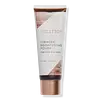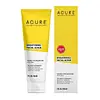What's inside
What's inside
 Key Ingredients
Key Ingredients

 Benefits
Benefits

 Concerns
Concerns

 Ingredients Side-by-side
Ingredients Side-by-side

Glycerin
HumectantCaprylic/Capric Triglyceride
MaskingEthyl Macadamiate
Skin ConditioningSodium Laurylglucosides Hydroxypropylsulfonate
CleansingOlea Europaea Fruit Oil
MaskingJuglans Regia Shell Powder
AbrasiveHelianthus Annuus Seed Oil
EmollientSesamum Indicum Seed Oil
EmollientMalt Flour
Skin ConditioningTocopherol
AntioxidantSucrose Palmitate
EmollientGlyceryl Caprylate
EmollientSilica
AbrasiveCurcuma Longa Root Extract
MaskingGlyceryl Undecylenate
EmollientLeuconostoc/Radish Root Ferment Filtrate
AntimicrobialSantalum Album Extract
CleansingWater
Skin ConditioningGlycerin, Caprylic/Capric Triglyceride, Ethyl Macadamiate, Sodium Laurylglucosides Hydroxypropylsulfonate, Olea Europaea Fruit Oil, Juglans Regia Shell Powder, Helianthus Annuus Seed Oil, Sesamum Indicum Seed Oil, Malt Flour, Tocopherol, Sucrose Palmitate, Glyceryl Caprylate, Silica, Curcuma Longa Root Extract, Glyceryl Undecylenate, Leuconostoc/Radish Root Ferment Filtrate, Santalum Album Extract, Water
Water
Skin ConditioningAloe Barbadensis Leaf Juice
Skin ConditioningGlycerin
HumectantSodium Methyl Cocoyl Taurate
CleansingJuglans Regia Shell Powder
AbrasiveKaolin
AbrasiveSodium Lauroamphoacetate
CleansingCitrus Limon Peel
MaskingSodium PCA
HumectantSodium Lauroyl Lactylate
EmulsifyingGlyceryl Laurate
EmollientSodium Cocoyl Isethionate
CleansingOlea Europaea Fruit Oil
MaskingLaminaria Digitata Powder
Skin ConditioningLilium Candidum Leaf Cell Extract
Skin ConditioningEuterpe Oleracea Fruit Extract
Rubus Fruticosus Fruit Extract
AstringentRosa Canina Fruit Extract
AstringentPunica Granatum Extract
AstringentCalendula Officinalis Flower Extract
MaskingChamomilla Recutita Flower Extract
MaskingAspalathus Linearis Leaf Extract
Skin ConditioningCI 75810
Cosmetic ColorantChondrus Crispus Extract
Skin ConditioningArgania Spinosa Callus Culture Extract
Skin ConditioningChlorella Vulgaris Extract
Skin ConditioningHelianthus Annuus Seed Oil
EmollientCymbopogon Flexuosus Leaf Oil
MaskingMentha Viridis Leaf Oil
AstringentSalvia Sclarea Oil
MaskingLavandula Hybrida Oil
EmollientCellulose Gum
Emulsion StabilisingSodium Levulinate
Skin ConditioningGluconolactone
Skin ConditioningPotassium Sorbate
PreservativeWater, Aloe Barbadensis Leaf Juice, Glycerin, Sodium Methyl Cocoyl Taurate, Juglans Regia Shell Powder, Kaolin, Sodium Lauroamphoacetate, Citrus Limon Peel, Sodium PCA, Sodium Lauroyl Lactylate, Glyceryl Laurate, Sodium Cocoyl Isethionate, Olea Europaea Fruit Oil, Laminaria Digitata Powder, Lilium Candidum Leaf Cell Extract, Euterpe Oleracea Fruit Extract, Rubus Fruticosus Fruit Extract, Rosa Canina Fruit Extract, Punica Granatum Extract, Calendula Officinalis Flower Extract, Chamomilla Recutita Flower Extract, Aspalathus Linearis Leaf Extract, CI 75810, Chondrus Crispus Extract, Argania Spinosa Callus Culture Extract, Chlorella Vulgaris Extract, Helianthus Annuus Seed Oil, Cymbopogon Flexuosus Leaf Oil, Mentha Viridis Leaf Oil, Salvia Sclarea Oil, Lavandula Hybrida Oil, Cellulose Gum, Sodium Levulinate, Gluconolactone, Potassium Sorbate
 Reviews
Reviews

Alternatives
Ingredients Explained
These ingredients are found in both products.
Ingredients higher up in an ingredient list are typically present in a larger amount.
Glycerin is already naturally found in your skin. It helps moisturize and protect your skin.
A study from 2016 found glycerin to be more effective as a humectant than AHAs and hyaluronic acid.
As a humectant, it helps the skin stay hydrated by pulling moisture to your skin. The low molecular weight of glycerin allows it to pull moisture into the deeper layers of your skin.
Hydrated skin improves your skin barrier; Your skin barrier helps protect against irritants and bacteria.
Glycerin has also been found to have antimicrobial and antiviral properties. Due to these properties, glycerin is often used in wound and burn treatments.
In cosmetics, glycerin is usually derived from plants such as soybean or palm. However, it can also be sourced from animals, such as tallow or animal fat.
This ingredient is organic, colorless, odorless, and non-toxic.
Glycerin is the name for this ingredient in American English. British English uses Glycerol/Glycerine.
Learn more about GlycerinHelianthus Annuus Seed Oil is the oil derived from the seeds of a Sunflower. Sunflower seed oil is non-fragrant. It is an emollient, meaning it helps to soften the skin.
Sunflower seed oil contains many fatty acids. The fatty acids found in sunflower seeds include (from highest amount to least): linoleic acid, myristic acid, palmitic acid, stearic acid, arachidic acid, oleic acid, and linolenic acid.
These fatty acids help the skin create ceramides. Ceramides play a role in repairing the skin barrier.
Helianthus Annuus Seed Oil helps moisturize the skin. This in turn helps the skin look more rejuvenated and smoother.
Sunflowers are rich in vitamin E.
Historians believe Indigenous cultures of North America domesticated sunflowers before corn. Thus they relied on sunflower oil for a variety of uses. One such use is moisturizing skin and hair.
Sunflower seed oil may not be fungal acne safe. We recommend speaking with a professional if you have any concerns.
Learn more about Helianthus Annuus Seed OilYou might know this ingredient as walnut shell powder. It is an abrasive used as a physical exfoliator.
Abrasives are physical exfoliants used to get rid of dead cell buildup on your skin. Physical exfoliators have a bad reputation due to the myth that they give your face tiny cuts. This is untrue.
Like any exfoliant, using this ingredient can disrupt your skin barrier. This can lead to breakouts, irritation, and dryness. It is critical to be gentle when using any type of exfoliator.
If you want to use a chemical exfoliator instead, check out glycolic acid.
Learn more about Juglans Regia Shell PowderOlea Europaea Fruit Oil is the fixed oil obtained from the ripe fruit of the Olive. In other words - olive oil.
The primary contents of olive oil are glycerides of the fatty acids linoleic, oleic and palmitic.
Olive oil also contains antioxidants such as Vitamin E. Antioxidants may help reduce signs of aging by fighting unstable free-radical molecules. It also contains Vitamins A (retinol), D, and K.
The squalene in olive oil makes it a great emollient. Emollients help soothe and soften your skin by trapping moisture in. This makes olive oil a great skin moisturizer.
Studies show olive oil to have antibacterial and antifungal properties in low concentrations. Another study found olive oil irritated sensitive oily skin. We always recommend speaking with a professional about using this ingredient in your routine.
Due to the fatty acid content, this ingredient may not be fungal-acne safe.
Learn more about Olea Europaea Fruit OilWater. It's the most common cosmetic ingredient of all. You'll usually see it at the top of ingredient lists, meaning that it makes up the largest part of the product.
So why is it so popular? Water most often acts as a solvent - this means that it helps dissolve other ingredients into the formulation.
You'll also recognize water as that liquid we all need to stay alive. If you see this, drink a glass of water. Stay hydrated!
Learn more about Water